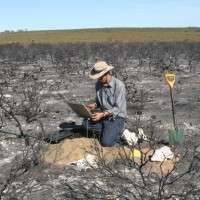Frequent fire and drying climate threaten WA plants

Murdoch University fire ecology experts have warned that in Western Australia's drying climate, many of the plant species which contribute to the stunning wildflower displays north of Perth may need 50 per cent longer between fires to maintain stable populations.
This prediction is based on studies of biodiverse Mediterranean-climate type shrublands near Eneabba, south western Australia, carried out by a team led by Professor Neal Enright and Dr Joe Fontaine from Murdoch's School of Veterinary and Life Sciences.
Heightened wildfire suppression and lengthened intervals between controlled burns may best support the longevity of the perennial plant species studied, but the scientists recognised that this contrasted with the view that more managed fire may be needed to mitigate wildfire risk as the climate warms.
"Our results highlight the potentially deadly biodiversity impacts of climate and fire regime change," said Professor Enright.
"Given a long-term decline in rainfall of 15 per cent for Perth and climate models predicting another 15 to 20 per cent drop by 2100, the consequences could be devastating for biodiversity in the region."
Dr Fontaine added: "It is alarming to think that in a warming, drying climate with an increased risk of wildfire, plant species which are a critical habitat to many animal and bird species like the honey possum and the Australian bustard, are threatened with decline in this way.
"The impact on local tourism might also be significant. Many businesses in the area depend on the annual flower show in areas like Mount Lesueur National Park for their livelihood."
Using experimental fires, the researchers measured the density of all shrub species before and after fire in 33 shrubland sites covering four post-fire rainfall years and fire intervals from three to 24 years.
They found that shortened fire intervals combined with declining rainfall put particularly sensitive groups of plants (e.g. those killed by fire) at a greater risk of local extinction. Under average conditions, their results suggested that the most sensitive plant species would self-replace at fire intervals of 10 years. But at 80 per cent of average winter rain, this threshold fire interval increased by 50 per cent to around 15 years.
Hardier species (e.g. those that can resprout after fire) may also become threatened as the impact of changing conditions makes it harder for the plants to replace themselves.
Dr Fontaine said: "Biodiversity levels in the shrublands might best be maintained if planned fire intervals are lengthened, rainfall conditions are considered and planned fires are only undertaken when a set of defined plant demographic and climate conditions are met."
"There have been plenty of studies of the potential impacts of global environmental change on the distribution and abundance of plant and animal species but most use models that predict future states based on a single factor," said Professor Enright.
"Our study tries to reflect the impact that interactions between a drying climate and increased incidences of wildfire are having on plant species."
More information: Enright, N. J., Fontaine, J. B., Lamont, B. B., Miller, B. P., Westcott, V. C. (2014), "Resistance and resilience to changing climate and fire regime depend on plant functional traits." Journal of Ecology. doi: 10.1111/1365-2745.12306
Journal information: Journal of Ecology
Provided by Murdoch University


















